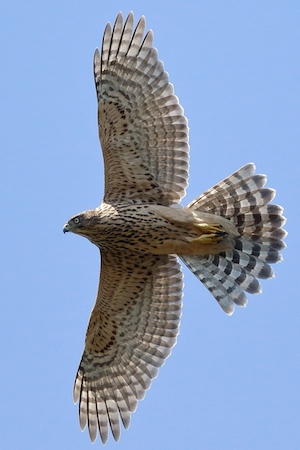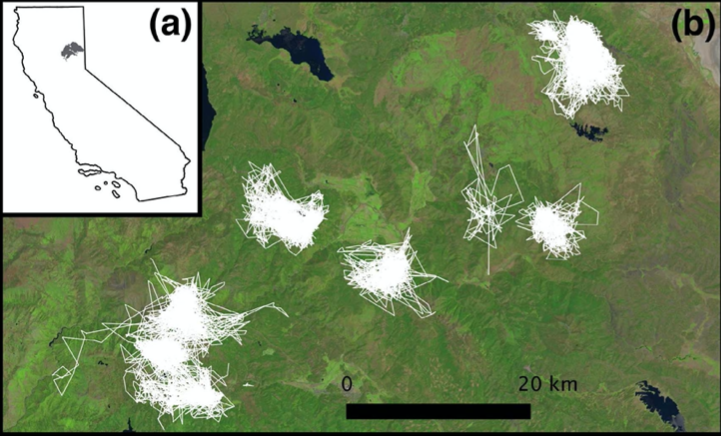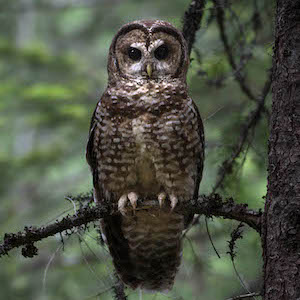Northern Goshawks (Accipiter gentilis) are typically elusive creatures and now they're getting even harder to find. Goshawk populations in western North America are declining as increasingly severe wildfire seasons, timber harvest, and forest thinning to mitigate wildfires alter their forest habitat. These fierce predators prefer dense forest and rely on stealth to hunt birds and small mammals, so they tend to keep a low profile. You are unlikely to catch more than a glimpse of them unless you're near their nest, in which case they'll make it very clear–via loud calls and dive bombing–that you are NOT welcome.
It's important to give goshawk nests some space, and this is exactly the conservation approach taken by many land managers. On US Forest Service lands in California, the management strategy for goshawks relies on "Protected Activity Centers" or PACs, essentially an 81-hectare bubble around a known or suspected Northern Goshawk nest, within which timber harvest or other habitat-altering activities are limited to avoid disturbing the birds. But is 81 hectares, or about 200 acres, enough room for a goshawk to roam?
That's one of the things the Forest Service wanted to know when it asked IBP to study the birds’ movements and space usage throughout their forest habitat. The result is a study published last month in the Journal of Raptor Research. IBP research associate Dr. Rachel Blakey, along with colleagues from IBP, the US Geological Survey and the US Forest Service, used GPS transmitters to track the movements of Northern Goshawks in the Plumas National Forest in California. They used this data to estimate home range size and distance traveled by individual goshawks, and evaluated how much of the habitat that the birds used was protected by PACs.

A goshawk on the move. Photo by Radovan Václav/Flickr
Previous studies of goshawk movements used devices or techniques that allowed the bird's location to be determined only infrequently, but the solar-powered GPS devices used in this study reported the goshawk's daytime location hourly during the breeding season and every four hours during the darker parts of the year. This allowed the researchers to get a more detailed view of the goshawks' movements than ever before.
They found that the goshawks' home ranges were quite large- around 3,000-4,000 hectares depending on the statistical method used to calculate their area, and individual birds sometimes travelled as much as 60 km/day during crisscrossing these areas during the breeding season. In addition, the more detailed view of goshawk movements allowed the researchers to detect infrequent but important behaviors like "forays,”, which were defined as movements of at least 5 km from the nest, and likely out of the bird's defended territory. These forays weren't quick jaunts- many birds were gone for over 24 hours and one female traveled 15 km from her nesting area.
Recording goshawks' locations more frequently won't always lead to larger home range estimates, but it does allow you to ask interesting questions about how the birds use space, says Blakey.
As you collect animal locations more frequently, you can ask ecological questions at finer temporal and spatial resolution and potentially identify interesting behaviors like forays and encounters with other birds. High resolution tracking also helps us understand habitat use at finer spatial scales like selection of smaller features including riparian zones, edges, tracks and small patches and at finer time-frames, like during different stages of the breeding season. This can become important when we are trying to evaluate management efforts, including how much time animals spend in protected areas or how animals respond to management approaches.
This study found that PACs in the Plumas National Forest are unlikely to protect more than 25% of the habitat used by goshawks during the nesting season. However, that 25% typically contains the nest and therefore probably protects the most sensitive portion of each goshawk pair’s haunts. But is that sufficent? Some studies have shown that goshawks are negatively affected by timber harvest across the landscapes they occupy, but other studies have shown some beneficial effects of forest thinning. Blakey says that we need more information on how forest management practices in the Sierra Nevada region affect Northern Goshawks and that conservation efforts may need to consider goshawk habitat needs on a larger scale.
In the meantime, the goshawks keep Blakey guessing. "We see that goshawks are travelling long distances from their nests (> 8 km) and passing through adjacent territories. What are they up to?" she wonders.

From Figure 1 in Blakey et al., 2020. (a) map showing the study area in Plumas National Forest in CA. (b) white lines tracing goshawk movements are overlayed on satellite imagery.






